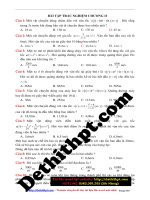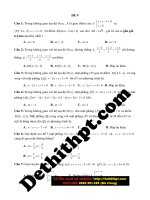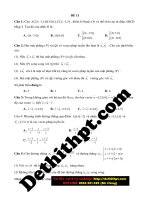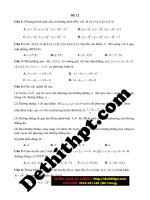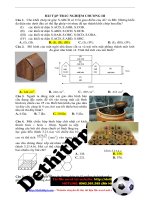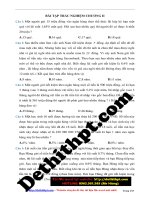ĐỀ 52 image marked image marked
Bạn đang xem bản rút gọn của tài liệu. Xem và tải ngay bản đầy đủ của tài liệu tại đây (750.78 KB, 7 trang )
Exercise 52:
Read the following pasage and mark the letter A, B, C or D to indicate the correct answer to each of
the questions.
Native Americans probably arrived from Asia in successive
waves over several millennia, crossing a plain hundreds of miles
wide that now lies inundated by 160 feet of water released by
melting glaciers. For several periods of time, the first beginning
around 60,000 BC and the last ending around 7,000 BC, this land
bridge was open. The first people travelled in the dusty trails of
the animals they hunted. They brought with them not only their
families, weapons, and tools but also a broad metaphysical
understanding, sprung from dreams and visions and articulated in myth and song, which complemented
their scientific and historical knowledge of the lives of animals and people. All this they shaped in a
variety of languages, bringing into being oral literatures of power and beauty.
Contemporary readers, forgetting the origins of western epic, lyric, and dramatic forms, are easily
disposed to think of “literature” only as something written. But on reflection it becomes clear that the
more critically useful as well as the more frequently employed sense of the term concerns the artfulness
of the verbal creation, not its mode of presentation. Ultimately, literature is aesthetically valued,
regardless of language, culture, or mode of presentation, because some significant verbal achievement
results from the struggle in words between tradition and talent. Verbal art has the ability to shape out a
compelling inner vision in some skillfully crafted public verbal form.
Đăng ký file Word tại link sau
/>
Of course, the differences between the written and oral modes of expression are not without
consequences for an understanding of Native American literature. The essential difference is that a speech
event is an evolving communication, an “emergent form”, the shape, functions, and aesthetic values of
which become more clearly realized over the course of the performance. In performing verbal art, the
performer assumes responsibility for the manners as well as the content of the performance, while the
audience assumes the responsibility for evaluating the performer’s competence in both areas. It is this
intense mutual engagement that elicits the display of skill and shapes the emerging performance. Where
written literature provides us with a tradition of texts, oral literature offers a tradition of performances.
Trang 1
QUESTIONS
Question 1: Which of the following is NOT true of the Native American literature discussed in the
passage?
A. It has a set form.
B. It expresses an inner vision.
C. It involves acting.
D. It has ancient origins.
Question 2: What is the author's attitude toward Native American literature?
A. Critical of the cost of its production
B. Skeptical about its origins
C. Admiring of its form
D. Amused by its content
Question 3: According to the passage, what responsibility does the audience of a verbal art performance
have?
A. They participate in the performance by chanting responses.
B. They determine the length of the performance by requesting a combination.
C. They provide financial support for performances.
D. They judge the quality of the content and presentation.
Question 4: What can be inferred about the nature of the Native American literature discussed in the
passage?
A. It is reshaped each time it is experienced.
B. It reflects historical and contemporary life in Asia.
Trang 2
C. Its main focus is on daily activities.
D. It is based primarily on scientific knowledge.
Question 5: What is the main point of the second paragraph?
A. Oral narratives are a valid form of literature.
B. Native Americans have a strong oral tradition in art.
C. The production of literature provides employment for many artists.
D. Public performance is essential to verbal art.
Question 6: The word "ultimately" in paragraph 2 is closet in meaning to ____.
A. in the end
B. frequently
C. whenever possible
D. normally
Question 7: According to the passage, why did the first people who came to North America leave their
homeland?
A. They were hoping to fid a better climate.
B. They were looking for food.
C. They were following instructions given in a dream.
D. They were seeking freedom.
Question 8: What can be inferred from the passage about the difference between written and oral
literature?
A. Written literature involves less interaction between audience and creator during the creative progress
than oral literature does.
B. Written literature reflects social values better than oral literature does.
C. Written literature is not as highly respected as oral literature is.
D. Written literature is not usually based on historical events, whereas oral literature is.
Question 9: The word "compelling" at the end of paragraph 2 is closet in meaning to _______.
A. joyous
B. competing
C. intricate
D. forceful
Question 10: The phrase "are easily disposed" in the second paragraph is closest in meaning to_____.
A. often fail
B. have a tendency
C. readily encourage others
D. demonstrate reluctance
GIẢI CHI TIẾT
Question 1: Which of the following is NOT true of the Native American literature discussed in the
passage?
A. It has a set form.
B. It expresses an inner vision.
Trang 3
C. It involves acting.
D. It has ancient origins.
Dịch nghĩa: Điều nào sau đây không đúng về văn học Mỹ bản địa trong bài viết?
A. Nó có một dạng cố định.
B. Nó thể hiện một cái nhìn bên trong.
C. Nó đòi hỏi diễn xuất.
D. Nó có một nguồn gốc xa xưa.
Giải thích: Đọc bài ta thấy văn học Mỹ có 2 dạng là oral (truyền miệng) và written (viết) linh hoạt với
nhau.
Question 2: What is the author's attitude toward Native American literature?
A. Critical of the cost of its production
B. Skeptical about its origins
C. Admiring of its form
D. Amused by its content
Dịch nghĩa: Thái độ của nhà văn như thế nào đối với văn học Mỹ bản địa?
A. Phê phán cái giá của việc làm ra nó
B. Nghi hoặc về nguồn gốc của nó
C. Ngưỡng mộ hình thức của nó
D. Cảm thấy thích thú với nội dung của nó
Giải thích: Đọc câu cuối bài viết: "Where written literature provides US with a tradition of texts, oral
literature offers a tradition of performances" - "Khi văn học viết cho chúng ta một truyền thống văn tự,
văn học nói lại cho ta một truyền thống biểu diễn."
→ Có thể thấy tác giả rất ngưỡng mộ sự đa dạng trong văn học Mỹ.
Question 3: According to the passage, what responsibility does the audience of a verbal art performance
have?
A. They participate in the performance by chanting responses.
B. They determine the length of the performance by requesting a combination.
C. They provide financial support for performances.
D. They judge the quality of the content and presentation.
Dịch nghĩa: Theo bài viết, khán giả của màn trình diễn nghệ thuật nói có nhiệm vụ gì?
A. Họ tham gia vào màn trình diễn bằng cách hô to câu trả lời.
B. Họ quyết định độ dài của màn trình diễn bằng cách yêu cầu một sự kết hợp.
C. Họ cung cấp hỗ trợ về tài chính cho buổi diễn.
D. Họ đánh giá giá trị của nội dung và hình thức trình bày.
Giải thích: Đọc dòng 6 từ dưới lên đoạn 3: "while the audience assumes the responsibility for evaluating
the performers'competence in both areas"-"trong khi khán giả có trách nhiệm đánh giá khả năng của
người trình diễn thông qua cả 2 phương diện"
Question 4: What can be inferred about the nature of the Native American literature discussed in the
passage?
A. It is reshaped each time it is experienced.
B. It reflects historical and contemporary life in Asia.
C. Its main focus is on daily activities.
Trang 4
D. It is based primarily on scientific knowledge.
Dịch nghĩa: Có thể rút ra điều gì về bản chất của văn học Mỹ bản địa được thảo luận trong bài viết?
A. Nó được thay đổi sau mỗi lần trải nghiệm.
B. Nó phản ánh lịch sử và cuộc sống đương đại ở châu Á.
C. Trọng tâm chính của nó là hoạt động hàng ngày.
D. Nó dựa chủ yếu vào kiến thức khoa học.
Giải thích: Đọc đoạn 2 ta thấy với mỗi độc giả, mỗi trải nghiệm khác nhau, văn học Mỹ bản địa lại được
nhìn nhận một cách khác nhau.
Question 5: What is the main point of the second paragraph?
A. Oral narratives are a valid form of literature.
B. Native Americans have a strong oral tradition in art.
C. The production of literature provides employment for many artists.
D. Public performance is essential to verbal art.
Dịch nghĩa: Ý chính của đoạn 2 là gì?
A. Những bản truyền miệng là một dạng chính thức của văn học.
B. Những người Mỹ bản địa có một truyền thống truyền miệng trong nghệ thuật lớn mạnh.
C. Quá trình tạo ra văn học cung cấp việc làm cho rất nhiều nghệ sĩ.
D. Những buổi diễn quần chúng là thiết yếu cho nghệ thuật truyền miệng.
Giải thích: Đọc câu đầu đoạn 2: "Contemporary readers, forgetting the origins of western epic, lyric and
dramatic forms, are easily disposed to think of "literature" only as something written"- "Những độc giả
đương thời, quên mất nguồn gốc, lời và những dạng khác nhau của anh hùng ca phương Tây, dễ dàng
nghĩ về "văn học" chỉ như một thứ gì đó được viết ra"
→ Sau đó tác giả đã chứng minh văn học nói cũng là một dạng được chấp nhận của văn học.
Question 6: The word "ultimately" in paragraph 2 is closet in meaning to ____.
A. in the end
B. frequently
C. whenever possible
D. normally
Dịch nghĩa: Từ "ultimately" ở đoạn 2 gần nghĩa nhất với ________.
A. cuối cùng
B. thường xuyên
C. bất cứ khi nào có thể
D. thường thường
Giải thích: Ta có: ultimately = in the end: cuối cùng thì...
Question 7: According to the passage, why did the first people who came to North America leave their
homeland?
A. They were hoping to fid a better climate.
B. They were looking for food.
C. They were following instructions given in a dream.
D. They were seeking freedom.
Trang 5
Dịch nghĩa: Theo bài viết, tại sao những người đầu tiên đến Bắc Mỹ rời bỏ quê hương họ?
A. Họ hy vọng một khí hậu tốt hơn.
B. Họ đang tìm kiếm thức ăn.
C. Họ đang theo chỉ dẫn trong một giấc mơ.
D. Họ đang tìm kiếm tự do.
Giải thích: Đọc dòng 5-6 đoạn 1: "The first people traveled in the dusty trails of the animals they
hunted"-"Những người đầu tiên đi theo dấu vết của những con vật họ săn bắn."
→ Như vậy có thể hiểu là họ đang tìm kiếm thức ăn.
Question 8: What can be inferred from the passage about the difference between written and oral
literature?
A. Written literature involves less interaction between audience and creator during the creative
progress than oral literature does.
B. Written literature reflects social values better than oral literature does.
C. Written literature is not as highly respected as oral literature is.
D. Written literature is not usually based on historical events, whereas oral literature is.
Dịch nghĩa: Có thể rút ra điều gì từ bài viết về sự khác biệt giữa văn học viết và nói?
A. Văn học viết bao gồm ít sự tương tác giữa khán giả và người sáng tạo ra trong quá trình sáng tạo
hơn văn học nói.
B. Văn học viết phản ánh những giá trị xã hội tốt hơn văn học nói.
C. Văn học viết không được đánh giá cao như văn học nói.
D. Văn học viết không thường dựa trên những sự kiện lịch sử, trong khi văn học nói thì có.
Giải thích: Đọc đoạn 3: "In performing verbal art, the performer assumes responsibility for the manner as
well as the content of performance, while the audience assumes the responsibility to evaluating the
performers'competence in both areas. It is this intense mutual engagement that elicits the display of
skills and shapes the emerging performance"- "Khi biểu diễn nghệ thuật nói, nghệ sĩ có trách nhiệm cho
phong cách cũng như nội dung của buổi biểu diễn, trong khi khán giả có trách nhiệm đánh giá khả năng
của người trình diễn thông qua cả 2 phương diện. Chính là ở sự tương tác chặt chẽ này mà đã làm lộ ra
sự trình diễn kĩ năng và tạo nên màn trình diễn mới nổi"
Question 9: The word "compelling" at the end of paragraph 2 is closet in meaning to _______.
A. joyous
B. competing
C. intricate
D. forceful
Dịch nghĩa: Từ "compelling" ở cuối đoạn 2 gần nghĩa nhất với ________.
A. vui mừng
B. tranh đấu
C. lộn xộn
D. bắt buộc
Giải thích: (to) be compelling = (to) be forceful = (to) be compulsory: mang tính bắt buộc
Question 10: The phrase "are easily disposed" in the second paragraph is closest in meaning to_____.
A. often fail
B. have a tendency
C. readily encourage others
D. demonstrate reluctance
Dịch nghĩa: Cụm từ "are easily disposed" ở đoạn 2 gần nghĩa nhất với ____.
Trang 6
A. thường thất bại
B. có một xu hướng
C. sẵn sàng ủng hộ người khác
D. thể hiện sự chần chừ
Giải thích: Ta có: (to) be easily disposed to v = (to) have a tendency to V: có xu hướng làm gì
DỊCH BÀI
Những người Mỹ bản địa có lẽ đã đến từ châu Á qua những làn sóng nối tiếp nhau qua hàng thiên
niên kỉ, băng qua một thảo nguyên rộng hàng trăm dặm mà ngày nay đã bị nhấn chìm bởi 160 feet nước
biển từ những sông băng tan chảy. Trong một vài khoảng thời gian, lượt người di cư đầu tiên bắt đầu
khoảng 60 ngàn năm trước công nguyên và lượt cuối cùng khoảng 7 ngàn năm trước công nguyên, cây
cầu đất liền này đã rộng mở. Những người đầu tiên đi theo dấu vết của những con vật họ săn bắn. Họ đã
mang theo không chỉ gia đình họ, vũ khí và công cụ, mà còn một sự hiểu biết siêu hình rộng lớn, xuất
phát từ những giấc mơ của họ, và tầm nhìn rõ ràng trong những truyền thuyết và bài hát, những điều đã
bổ sung cho kiến thức về khoa học và lịch sử của họ về cuộc sống của động vật và con người. Tất cả
những điều này họ đã tạo nên trong nhiều loại ngôn ngữ, mang đến sự ra đời của văn học truyền miệng về
sức mạnh và vẻ đẹp.
Những độc giả đương thời, quên mất nguồn gốc, lời và những dạng khác nhau của những bản anh
hùng ca phương Tây, dễ dàng nghĩ về "văn học" chỉ như một thứ gì đó được viết ra. Nhưng khi được phản
ánh nó trở nên rõ ràng và có tác dụng rất lớn cũng như cảm nhận thường thấy hơn về khái niệm liên quan
đến tính nghệ thuật của những tác phẩm bằng lời nói, chứ không phải là cách trình bày nó. Cuối cùng, văn
học được thẩm định về mặt thẩm mỹ, không phân biệt ngôn ngữ, văn hóa, hay hình thức trình bày, bởi vì
một vài những thành quả của nghệ thuật bằng lời nói là kết quả của nỗ lực của sự đấu tranh giữa truyền
thống và tài năng. Nghệ thuật lời nói có khả năng định hình một cái nhìn bắt buộc bên trong trong một vài
dạng lời nói được trau chuốt một cách công phu trước đám đông.
Tất nhiên, điểm khác biệt giữa dạng giao tiếp viết và nói không phải là không gây hậu quả cho cách
hiểu văn học Mỹ bản địa. Điểm khác biệt chủ yếu là một chuỗi lời nói là một quá trình giao tiếp thay đổi,
một "dạng biến đổi", hình dạng, chức năng, và giá trị thẩm mỹ của chúng trở nên được công nhận rõ ràng
hơn thông qua trình diễn. Khi biểu diễn nghệ thuật ngôn từ, nghệ sĩ có trách nhiệm cho phong cách cũng
như nội dung của buổi biểu diễn, trong khi khán giả có trách nhiệm đánh giá khả năng của người trình
diễn thông qua cả 2 phương diện. Chính sự tương tác chặt chẽ này đã giúp thể hiện kĩ năng của nghệ sĩ và
tạo nên những màn trình diễn nổi bật. Khi văn học viết cho chúng ta một truyền thống văn tự, văn học nói
lại cho ta một truyển thống biểu diễn.
Trang 7
